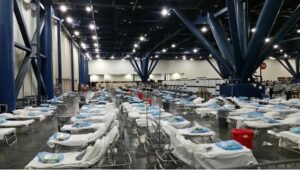
Disasters, whether natural or man-made, can strike at any time. From hurricanes and floods to disease outbreaks and industrial accidents, these events affect communities in ways that go beyond immediate damage. One of the most important but often overlooked aspects of disaster preparedness is public health. While first responders and emergency crews handle rescue and recovery, public health professionals work behind the scenes to protect the well-being of entire communities before, during, and after crises.
Their efforts help reduce the spread of disease, ensure access to clean water and food, and support mental health in times of distress. Public health disaster preparedness is about building systems that keep people safe and help them recover. In today’s world, with challenges like climate change and global pandemics becoming more common, the role of public health in disaster readiness has never been more critical. However, to do this work well, professionals need the right skills and training to plan, respond, and lead during emergencies.
How Education Prepares Public Health Leaders for Disaster Management
Managing public health during disasters is complex. It takes careful planning, clear communication, and the ability to coordinate with many different organizations. It isn’t something people can do with good intentions alone. It requires education and hands-on experience. Many future public health professionals choose to pursue an MPH in disaster management because these programs provide the mix of knowledge and practical skills needed for this challenging field.
It helps students learn how to design emergency preparedness plans, organize responses across agencies, and support communities during recovery. The program covers key areas like epidemiology, health policy, risk communication, and leadership. It also offers real-world learning so graduates can step into roles where they help protect health and safety when disasters strike. With flexible online options, these programs make it easier for people to gain the expertise needed while balancing work and other responsibilities.
The Role of Public Health in Planning and Prevention
A lot of what keeps communities safe during disasters happens long before a crisis begins. Public health professionals work with local leaders, healthcare providers, and emergency teams to create plans that address the unique needs of their communities. These plans help ensure that when disaster strikes, there is a clear path for action.
Public health also focuses on prevention. It might include vaccination campaigns to stop the spread of disease during an emergency or education efforts to help people prepare their homes and families. These steps reduce the risk of harm and give communities a stronger foundation to face challenges. Planning and prevention are key parts of public health’s role in building resilience and saving lives.
How Public Health Supports Communities During Disasters
When a disaster happens, public health systems step in to help protect people in real-time. They coordinate the delivery of medical supplies, support shelters with clean water and sanitation, and provide mental health services to those affected. Their work helps keep communities safe while other emergency teams focus on rescue operations.
Clear communication is another critical piece. Public health professionals provide accurate, timely information to help people make informed choices during emergencies. It helps reduce panic and confusion, ensuring that communities can respond in a more organized way. By supporting both immediate needs and longer-term health, public health teams play a central role in disaster response.
The Link Between Public Health and Recovery
The work of public health doesn’t end when the immediate danger has passed. Recovery is often a long process, and public health professionals help guide communities through it. They make sure people have access to clean water, safe food, and essential health services. They also support long-term mental health care and chronic disease management for those impacted by the disaster.
In addition, public health teams review and evaluate how their plans worked during the crisis. It helps improve future preparedness efforts so that communities are even better equipped next time. By focusing on both immediate recovery and long-term well-being, public health professionals help communities heal and rebuild stronger. They often work closely with local leaders, healthcare providers, and community organizations to rebuild trust and address new health concerns that may emerge after a disaster. Education and outreach continue during recovery as public health teams provide information on safe practices, available services, and ways to reduce future risks. Their ongoing efforts are essential in helping communities not only recover but thrive.
The Growing Need for Skilled Public Health Professionals in Disaster Preparedness
Today’s world presents new and complex challenges. Climate change leads to more severe weather events. Urbanization means more people are living in disaster-prone areas. Global travel increases the risk of disease outbreaks spreading quickly. All of this means that communities need skilled public health professionals who can design and lead effective disaster preparedness efforts.
Education plays a vital role in preparing these professionals. Programs like a master’s in disaster management give future leaders the tools they need to protect health and safety during crises. From creating emergency response plans to managing recovery efforts, well-trained public health workers are essential to building communities that can withstand and recover from disasters. The demand for these skilled individuals will only continue to grow as communities face new risks and challenges.
Public health is a vital part of disaster preparedness. Its role in planning, prevention, response, and recovery helps protect lives and support communities through some of their most difficult times. The work of public health professionals ensures that when disasters strike, communities have the resources, plans, and support they need to stay safe and recover.
Strong public health systems save lives, reduce harm, and build resilience. By investing in public health education and supporting these essential efforts, we can all help create safer, healthier communities ready to face whatever comes their way.







